
Fucus vesiculosus, known by the common names bladder wrack, black tang, rockweed, sea grapes, bladder fucus, sea oak, cut weed, dyers fucus, red fucus and rock wrack, is a seaweed found on the coasts of the North Sea, the western Baltic Sea and the Atlantic and Pacific Oceans. It was the original source of iodine, discovered in 1811, and was used extensively to treat goitre, a swelling of the thyroid gland related to iodine deficiency.

Brown algae, comprising the class Phaeophyceae, are a large group of multicellular algae, including many seaweeds located in colder waters within the Northern Hemisphere. Brown algae are the major seaweeds of the temperate and polar regions. They are dominant on rocky shores throughout cooler areas of the world. Most brown algae live in marine environments, where they play an important role both as food and as a potential habitat. For instance, Macrocystis, a kelp of the order Laminariales, may reach 60 m (200 ft) in length and forms prominent underwater kelp forests. Kelp forests like these contain a high level of biodiversity. Another example is Sargassum, which creates unique floating mats of seaweed in the tropical waters of the Sargasso Sea that serve as the habitats for many species. Many brown algae, such as members of the order Fucales, commonly grow along rocky seashores. Some members of the class, such as kelps, are used by humans as food.

Arame, sea oak is a species of kelp, of the brown algae, best known for its use in Japanese cuisine.

The largehead hairtail or beltfish is a member of the cutlassfish family, Trichiuridae. This common to abundant species is found in tropical and temperate oceans throughout the world. The taxonomy is not fully resolved, and the Atlantic, East Pacific and Northwest Pacific populations are also known as Atlantic cutlassfish, Pacific cutlassfish and Japanese cutlassfish, respectively. This predatory, elongated fish supports major fisheries.
Eisenia arborea, or the southern sea palm, is a dominant species of kelp that is found on the western Pacific coast of North America, from Vancouver Island, Canada south to Mexico's Isla Magdalena and Baja California, as well as in Japan. They are commonly found from the midtidal areas stretching to the subtidal areas. It is an edible seaweed, a source of nutrients for grazing marine invertebrates and a source of alginic acid, a food thickener. Some of the algas have a hollow stipe above its holdfast with two branches terminating in multiple blades. Eisenia arborea is studied in order to predict environmental stress in oceans intertidal zones. Hollow stipes where present when the Eisenia arborea did not receive essential nutrients for its thalli development. Eisenia arborea with hollow stripes are believed to be evolved algae in order to increase their survival in harsh living conditions. They play a huge role in determining environmental stress.
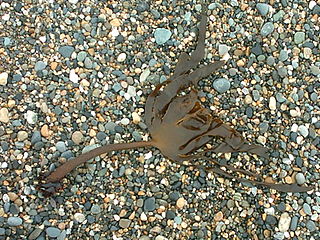
Ecklonia cava, is an edible marine brown alga species found in the ocean off Japan and Korea.

Sargassum muticum, commonly known as Japanese wireweed, is a large brown seaweed of the genus Sargassum. It is an invasive seaweed with high growth rate. It has an efficient dispersion thanks to its floats.
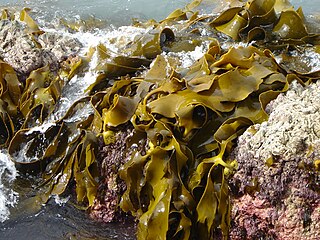
Phlorotannins are a type of tannins found in brown algae such as kelps and rockweeds or sargassacean species, and in a lower amount also in some red algae. Contrary to hydrolysable or condensed tannins, these compounds are oligomers of phloroglucinol (polyphloroglucinols). As they are called tannins, they have the ability to precipitate proteins. It has been noticed that some phlorotannins have the ability to oxidize and form covalent bonds with some proteins. In contrast, under similar experimental conditions three types of terrestrial tannins apparently did not form covalent complexes with proteins.

Eckol is a phlorotannin isolated from brown algae in the family Lessoniaceae such as species in the genus Ecklonia such as E. cava or E. kurome or in the genus Eisenia such as Eisenia bicyclis.
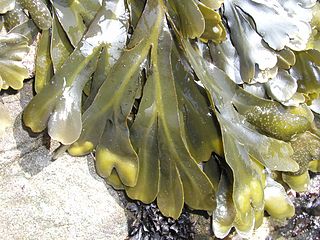
Fucus gardneri is a species of seaweed, a brown alga living on the littoral shore of the Pacific coasts of North America. It has the common names of rockweed and bladderwrack.

Neorhodomela larix, commonly known as black pine, is a species of red algae native to coastal areas of the North Pacific, from Mexico to the Bering Sea to Japan. It forms dense mats on semi-exposed rocks in intertidal areas. The thallus is dark brown to black in color with whorled branches resembling a bottlebrush.
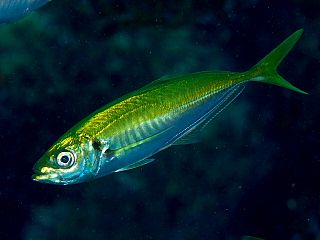
The Japanese jack mackerel, also known as the Japanese horse mackerel or Japanese scad, is a species named after its resemblance to mackerel but which is in the family Carangidae, the jacks, pompanos, trevallies and scads. Their maximum reported length is 50 cm (20 in) with a common length of 35 cm (14 in). They have a maximum reported weight of 0.66 kg (1.5 lb) and a maximum reported age of 12 years. They are found around the coast of Japan, apart from Okinawa Island, usually on sandy bottoms of 50–275 m (164–902 ft) deep. They feed mainly on small crustaceans such as copepods, and shrimps and small fish. They are similar to the yellowtail horse mackerel around New Zealand and Australia, apart from having more gill rakers and larger eyes.
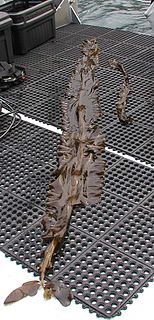
Alaria marginata, the winged kelp, is a brown alga species in the genus Alaria. It can grow up to 13 feet. Fronds are long and narrow with raised midrib and wavy edges. Each frond has two rows of several smooth, oblong, 5 inch spore-bearing blades at the base in winter.

Apostichopus japonicus is a species of sea cucumber in the family Stichopodidae. It is found in shallow temperate waters along the coasts of south east Asia and is commonly known as the Japanese spiky sea cucumber or the Japanese sea cucumber.
Ecklonia stolonifera is a brown alga species in the genus Ecklonia found in the Sea of Japan. It is an edible species traditionally eaten in Japan.
Ecklonia kurome is a brown alga species in the genus Ecklonia found in the Sea of Japan.

Tetrafucol A is a fucol-type phlorotannin found in the brown algae Ascophyllum nodosum, Analipus japonicus and Scytothamnus australis.
Sargassum ringgoldianum is a brown alga species in the genus of Sargassum. The ethanol extract of S. ringgoldianum contains phlorotannins of the bifuhalol type, which shows an antioxidative activity.

Scytothamnus australis is a brown alga species in the genus Scytothamnus found in New Zealand. It is a sulphated polysaccharide and the type species in the genus.

Acinetospora crinita is a species of brown alga in the family Acinetosporaceae. It is found in the temperate northeastern Atlantic Ocean and the Mediterranean Sea.
















